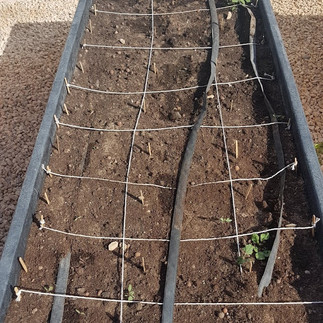6 Subjects that can be taught in a school garden (other than science)
- jackieschem
- Aug 26, 2021
- 3 min read
Updated: Sep 16, 2021
Cross-curricular lessons for hands on learning in your school garden

1. Engineering & Design
Struggling to find learning engagements that hit the "E" in STEM? Head to the garden and design garden structures for your plants to climb
Which plants require structures to climb up? How tall do the structures need to be? What materials are best for use in a garden? How can we secure the structure with safe materials that can be reused over and over? How big do tomato cages need to be? How can we design strong structures that can hold the weight of vegetables and survive strong winds? Do beans prefer ladders or tee-pee structures? Designing for the garden is full of opportunities to engage students in a hands on open-ended inquiry learning experience. To incorporate sustainable design principles of the circular economy, students were challenged to design for disassembly and given material straints (no glue, tape or nails) and had to learn to secure their structures with yarn, twine and rubber bands. This is a unit of inquiry for Grade 2 students and by designing for easy disassembly, materials are used over and over every year.
2. Entrepreneurship & Career Skills
Want to teach students how to start and run a business? Start a garden market!
How much should we sell our produce for? What quantities should we sell? How do we make change and receive payment? How can we put that money back into the garden or donate it? What items sell best at the market? How do we advertise our market? How can we package our items zero waste? What time should we have our market open? Who is responsible for harvesting? So many great problems for students to work together to solve as they learn what it takes to organize themselves and run a small business.
3. Maths
The garden provides hands on learning for measurement skills, data collection and numeracy practice
When using the square foot gardening method, how many squares fit in our garden boxes? How much space is needed between plants? How tall did a plant grow in a day? A week? What is the volume of the soil in the boxes? How many Kg's of food waste did we collect for our compost this week? How many cups of beans did we grow this year? Where in the garden can you find the fibonacci sequence? How many litres of water did we use this week in the garden? We collect so much data in the garden and display this data all over the school. Once you start collecting data in your garden, you can use it again next year and have your students compare garden yields, soil quality, water use, plant height and so much more!
4. Character Education
Caring for a garden is a great way to build character and community. Good attitudes and attributes grow in a garden
How can we care for our garden? What is everyone's responsibility? How can we respectfully use water? What's the best way to share the materials and keep them tidy? How can we share our garden with the community? If you're a PYP school, the garden is a great place to work on developing those Learner Profile attributes. During this lesson we were planning a flower garden to represent our school diversity and the children came up with all sorts of great ideas of what types of flowers to plant.
5. Additional Language Learning
Create bilingual signs and labels in the garden to build language skills
What is this plant? How do we say and write it in Arabic? French? Spanish? Vocabulary learning in the garden is so much fun! Gardens are also great inspiration for poetry once your language learners have learned the basics and are ready for bigger writing tasks.
6. Art
From sketching plants to painting murals, the garden provides many opportunities for artistic skills to flourish
How can we use nature to create art? For Mother's Day, we made bookmarks by flowering pounding. Students collected colorful flowers from our garden and then used hammers to tap the flowers between sheets of paper to extract the colors. Our garden has inspired many art lessons, because nature is art.









































Comments